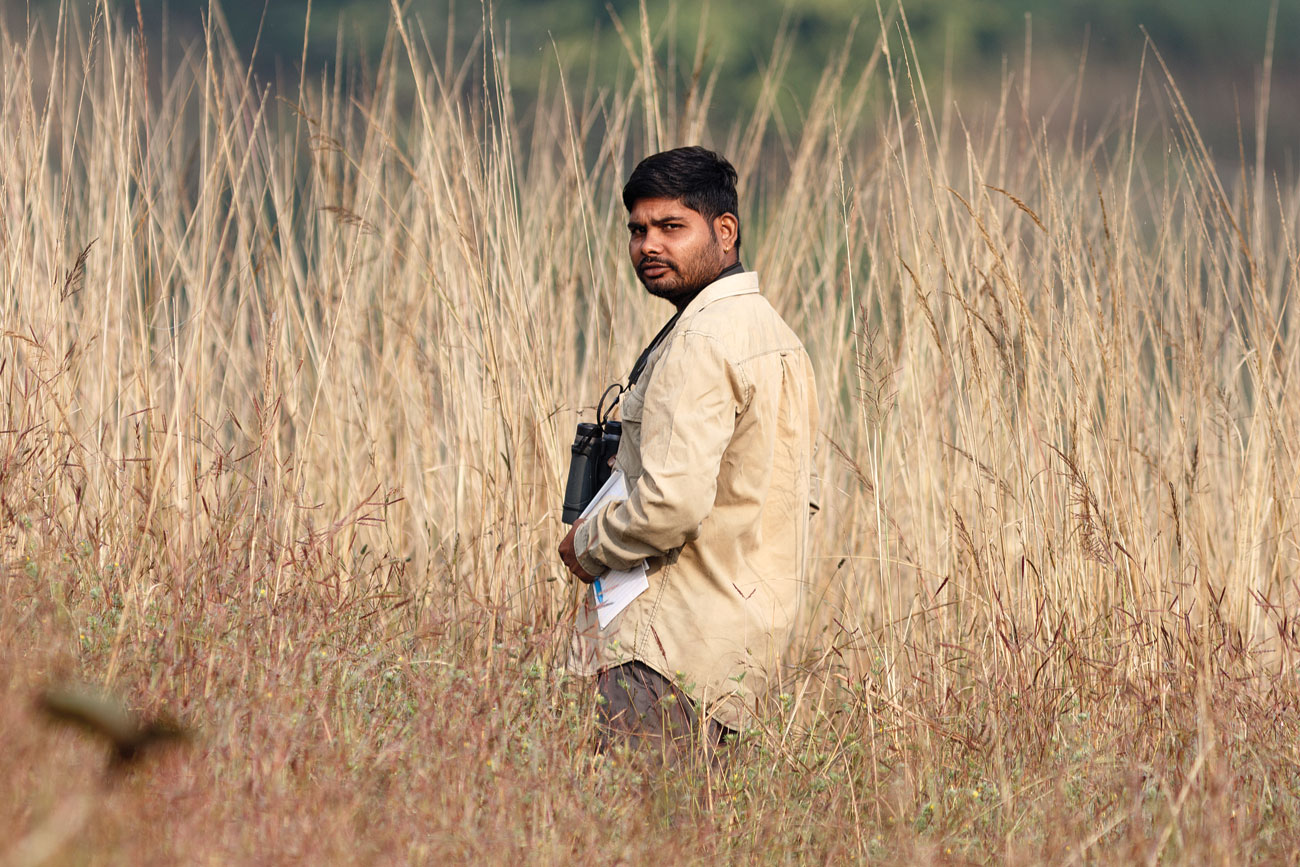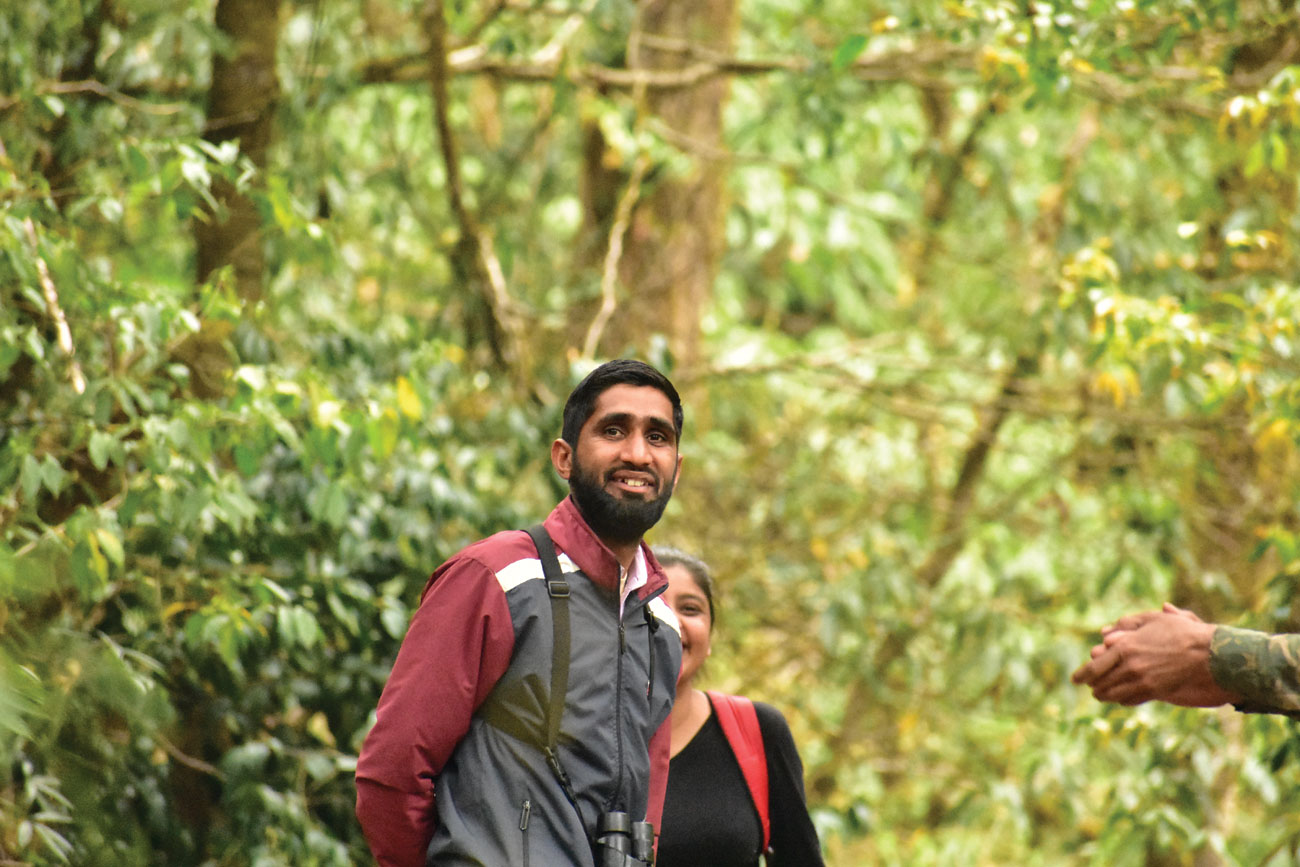'Meet Sanctuary's New Project Leaders'
First published in Sanctuary Asia,
Vol. 42
No. 12,
December 2022
Sanctuary’s Mud on Boots
Bimonthly Updates for September-October 2022
Meet our New Project Leaders!
This year, our team received over 35 nominations for the 2023-25 batch of Mud on Boots Project Leaders. While each nominee was found to be exceptional in their own right, we narrowed down the selection based on four criteria – mentorship availability, access to other opportunities, project urgency, and potential for growth. The final five projects we have chosen to support represent a diversity of personalities, landscapes, species, and approaches to biodiversity conservation. We are thrilled to work with them over the next two years and bring their stories to our readers and supporters.
Shashank Ladekar and Kanhaiya Udapure
Gondia district, Maharashtra

Shashank Ladekar are committed to working with Gram Panchayats in villages in Gondia district to strategise wetland management.
In the agricultural fields and ‘tanks’ of the Gondia district, Shashank Ladekar and Kanhaiya Udapure are protecting Sarus Cranes and working towards wetland conservation. These young conservationists are volunteers with a local organisation, Sustaining Environment and Wildlife Assemblages (SEWA), and field assistants to a Ph.D. researcher identifying opportunities for waterbird conservation in Central India. Over the years, Shashank and Kanhaiya have arranged wildlife awareness meetings in 55 villages and 20 schools in the buffer zones of the Navegaon-Nagzira Tiger Reserve; recorded the presence of the Indian grey wolf in new locations; rescued and rehabilitated injured wildlife; and assisted the Forest Department in managing human-wildlife encounters. They also monitor Sarus Crane nests in their districts and are planning to nurture a seed bank for wetland restoration efforts.

Kanhaiya Udapure are committed to working with Gram Panchayats in villages in Gondia district to strategise wetland management.
Drawing on their past experiences and skillset, Shashank and Kanhaiya are committed to working with Gram Panchayats in at least 10 villages across the district to strategise wetland management techniques that can support wildlife and provide livelihoods to people. While Kanhaiya is an excellent birder and fledging photographer, Shashank has the magic touch when it comes to animal care. With support from the Mud on Boots Project, this dedicated pair will give fresh impetus to wetland conservation in the state of Maharashtra.
Jesu Das
Mandya district, Karnataka

Jesu Das is committed to continuing his work toward humpback mahseer conservation.
Born in a village near Nanjangud town on the banks of the Kabini river, Jesu Das is a gifted fisherman with immense knowledge of fish, fish behaviour, and traditional fishing techniques. He has been working as a field operative with the Wildlife Association of South India (WASI), where he discovered new applications for his traditional skills and practices. His understanding of river ecology, keen observation skills, and accurate species’ identification have paved the way for the rediscovery of fish that were once believed to be locally extinct. He has led several field excursions into remote stretches of the Cauvery river basin, looking for the critically endangered and endemic humpback mahseer. His enthusiasm and zeal have led him to serve a crucial role at the Humpback Mahseer Repository Facility set up by the Karnataka Forest Department at Bheemeshwari.
With support from the Mud on Boots Project, Jesu is committed to continuing his work towards protecting the humpback mahseer by managing and stocking the Mahseer Repository Facility, providing orientation to visitors, educating his peers, and contributing to research projects underway in the Cauvery basin. Jesu will also be training interested youth in the age-old art of cast net fishing, to ensure the continuity and responsible application of this ancient and irreplaceable skill.
Saddam Husain Lodha,
Haridwar district, Uttarakhand

Saddam Husain Lodha will focus on nature education, conservation and mobilising youth volunteers.
Trained in birdwatching, plant identification, and bat research, Saddam Husain Lodha is an inspiring community conservation leader. Having initially worked daily wage jobs in apple orchards, poultry farms, and chemist shops, he went on to become a brilliant field assistant to researchers conducting studies in his district. Saddam is also a key member of Maee, a unique grassroots organisation founded and run by Van Gujjar youth from Gujjar Basti in Haridwar district, Uttarakhand. Their work ranges from increasing capacity and generating employment opportunities within their community, documenting traditional Gujjar knowledge of the forests, and improving knowledge of gender and sexual identity to imparting nature education and involving children in citizen science projects.
With support from the Mud on Boots Project, Saddam wants to sharpen Maee’s focus on nature education and conservation by leading local youth in monitoring populations of the barasingha or swamp deer in the Jhilmil Jheel Conservation Reserve and surrounding areas where they are hunted. Saddam also plans to mobilise Maee’s existing army of youth volunteers to monitor the birds around the Jhilmil Jheel Conservation Reserve, and form a street play troupe to perform plays as a form of nature education and outreach in Gaindikhata, Haridwar district, Uttarakhand.
Sahebram Bediya and Chamru Bediya
Ranchi district, Jharkhand

Sahebram Bediya plan to document the biodiversity in and around Jharkhand’s Koynardih village by involving community members.
Described as ‘a ray of hope for community-led conservation’ by their associates, Sahebram and Chamru Bediya are shaping new ideas in Jharkhand’s Koynardih village. The duo has excellent knowledge of the forests that surround their village and lead Ekastha Trails, a homegrown eco-tourism initiative that introduces tourists to nature via guided treks and trails. They also document local biodiversity, introduce community youth to wildlife conservation, and organise clean-up drives along their trails. Both conservationists are graduates of Green Hub’s Central India Fellowship and have been trained in video documentation. As members of the marginalised Bediya community, Sahebram and Chamru want to highlight Jharkhand’s wildlife, provide green jobs for their community, and use their cultural knowledge to reduce deforestation and hunting in their village.

Chamru Bediya plan to document the biodiversity in and around Jharkhand’s Koynardih village by involving community members.
During their term with the Mud on Boots Project, Sahebram and Chamru plan to document the biodiversity in and around Koynardih by involving interested community members. They will also work towards restoring degraded patches of forest. Independently, Sahebram will be creating videos on coexisting with wildlife, while Chamru will be developing their eco-tourism model to benefit their community.
Asukhomi Community Reserve Management Committee
Zunheboto district, Nagaland

People of Asukhomi village voluntarily surrendered their hunting weapons at a public meeting organised by the village council in Zunheboto on May 13, 2022. Photo Source: The Morung Express.

The Asukhomi Community Reserve Management Committee is dedicated to building an inclusive culture of community-based conservation.
In May 2022, the people of Asukhomi village voluntarily surrendered their guns and hunting weapons at a public meeting organised by the village council. This show of solidarity towards conservation efforts was guided by the 12 conservation-minded residents of Asukhomi village that comprise the Asukhomi Community Reserve Management Committee. Spread across 280 ha. of forest, the Asukhomi Community Reserve was notified in 2020 with the consent of locals. This lush forest ranges in elevation from 600 to 2,200 msl. and boasts a wide diversity of wild species. Through their persistent outreach programmes and using their strong social bonding skills, the committee has cultivated conservation practices that include the nurturing of native plants, sustainable collection of non-timber forest produce, and wildlife rescue and rehabilitation. The committee is also entrusted with awareness programmes, livelihood initiatives, and community outreach.

Borders neither authenticated or verified.
Dedicated to building an inclusive culture of community-based conservation in Asukhomi, the committee is now training youth to document biodiversity. With support from the Mud on Boots Project, they will create a local biodiversity register in both the Sumi dialect and the English language. This will be an invaluable document that will record not just biological diversity but will preserve local and traditional knowledge, and be used to develop an agenda for conservation action.










